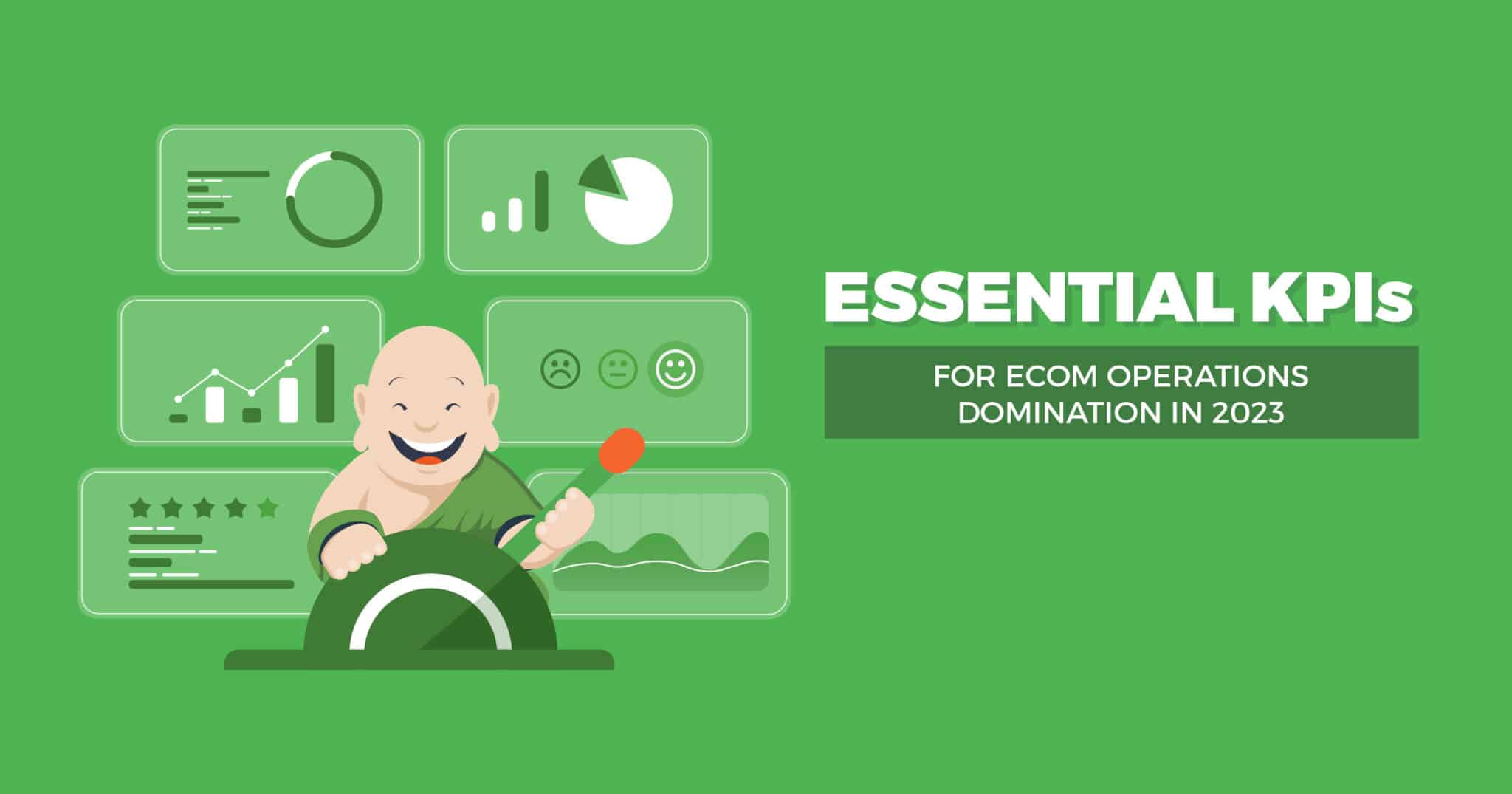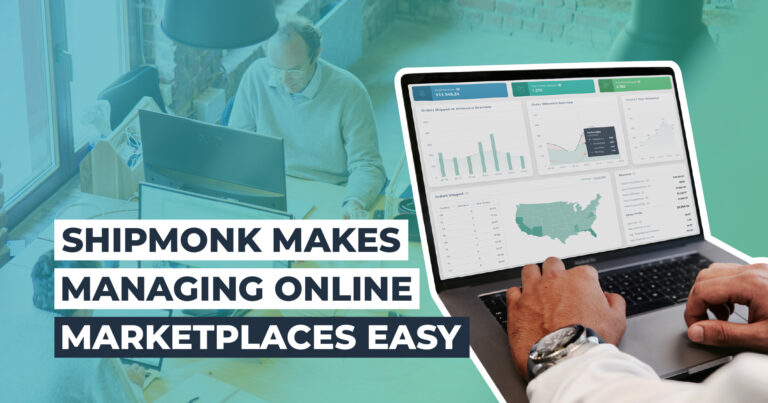Essential KPIs for Ecom Operations Domination in 2023
Most ecommerce business owners have a few key performance indicators (KPIs) that they track daily, if not hourly. Metrics like conversion rates and average order value can keep you up at night when you’re not meeting revenue goals. But there are a host of other metrics and KPIs on the operations side that have just as great an impact on the profitability of your ecommerce business.
In any ecommerce business, warehousing, ecommerce order fulfillment and shipping are among your largest line-item costs. This, of course, means that streamlining those warehousing and fulfillment operations can drive profitability. Whether you manage your own fulfillment warehouse or outsource ecommerce order fulfillment and logistics to a 3PL, there is always room for improvement. But how do you identify what is going well and what needs improving? This article will cover some of the most important metrics and KPIs to establish if you want to optimize your fulfillment operations.
Metrics vs. KPIs
Metrics and KPIs are often confused for one another, but there are subtle differences. A metric is any standard you use to measure or evaluate something, like sales figures or number of orders per day. A KPI, on the other hand, has been identified as a “key” metric to watch, with a performance goal attached to it. It tells you at a glance how you’re doing at meeting that goal. So while KPIs are metrics, not all metrics are KPIs.
Ecommerce businesses will all have ecommerce KPIs that are unique to their business. Warehouse KPIs, on the other hand, are pretty standard across the fulfillment industry since 3PLs and fulfillment warehouses perform the same basic processes. Tech-forward 3PLs with advanced warehouse management systems will be able to track performance on a more granular level so they can offer their ecommerce clients real-time data and customized reporting.
What to Watch For
Ecommerce order fulfillment is a complex process that involves a lot of moving parts — literally. Inventory moves in and out of warehouses, on and off shelves. Warehouse workers and advanced robots work side by side as orders are prioritized, picked, packed, and loaded onto trucks. When you think about it, it’s amazing that machines, humans, and dozens of integrated back-end technologies can all work in concert with one another to deliver millions of orders every day.
Metrics and KPIs can (and should) be established to identify bottlenecks in the process, positive and negative trends, areas that are improving, and areas that need improvement. When you start tracking metrics for productivity and accuracy, these are some of the signs that might indicate you need to dig deeper.
- Consistently Late Shipping
- Picking Errors
- Late Deliveries
- Damaged Merchandise
- Inventory Discrepancies
Breaking Down the Process
Let’s say you’ve noticed a lot of late deliveries recently. There might be any number of reasons for this, including but not limited to order fulfillment backlogs, inventory issues, and shipping delays. If you dig deeper into order backlogs, for instance, you might find multiple reasons for the backlog, such as an inefficient warehouse layout, an outdated order management system, an inability to handle spikes in order volume, or a lack of planning for them. To identify the root cause (or causes) of the problem, start by breaking the process into manageable chunks that you can examine individually. Areas to look might include:
- Receiving
- Slotting
- Inventory Management
- Order Management
- Pick and Pack
- Shipping and Delivery
To evaluate performance in each of these areas, you’ll need to establish KPIs that track the flow of inventory and orders from receiving to delivery, and watch them over time. Once you’ve identified an area that could use some improvement, you can test different solutions one at a time and use those same KPIs to track your progress. If you leave the KPIs in place, you’ll be able to monitor your performance moving forward.
Establishing KPIs
When outsourcing ecommerce fulfillment operations to a 3PL, one of the first things you should do is outline your expectations for fulfillment and establish KPIs that you will use to evaluate their performance. (A 3PL that does not take you through this process is not a company you want handling your precious inventory!) If you’re managing your own warehouse, establishing KPIs will be more difficult since you’ll have to work through this process on your own and invest in the systems needed to track them. Investing in a robust warehouse management system with order and inventory management capabilities can be cost prohibitive for smaller ecommerce businesses and DTC brands.
For each step of the fulfillment process there are unique KPIs to consider tracking. An advanced fulfillment system that offers customized reporting and real-time data lets you see important metrics at a glance and track them on a regular basis.
Receiving KPIs
Receiving is the process of boxing incoming merchandise at the warehouse, counting and sorting it, and examining it for quality issues. Larger 3PLs like ShipMonk may use dimensional scanners that weigh, measure, and photograph incoming merchandise, which helps them determine storage space as well as packaging size and shipping methods when fulfilling orders. The faster your inventory gets through receiving, the sooner it can be sold online — but speed should not come at the cost of accuracy. Miscounted, or mis-shelved merchandise can cause bigger problems down the road.
Supplier Accuracy — comparing quantity ordered versus quantity received to catch discrepancies
Receiving Efficiency — a measure of how much inventory is processed in a given timeframe which, if lower than normal, may indicate staffing issues or inefficient processes
Receiving Cycle Time — the time it takes to unbox, count, sort, measure, weigh, and label (if necessary) inventory after it arrives at the warehouse
Cost per Shipment — how much it costs in time and labor to receive inventory, tracked by line item or SKU.
Slotting KPIs
Slotting is the process of putting inventory on the shelves, but there’s a lot more to it than that. Each SKU will have an assigned storage shelf or bin. Making sure the right product gets in the right place is important. Digital warehousing, or the use of barcodes and digital scanners to track inventory as it moves through the warehouse, prevents errors. Smart warehouses like ShipMonk have sophisticated mapping software that determines the optimal place within the warehouse to store a particular SKU. For example, items that are ordered most frequently might be stored closest to the packing stations, or items that are frequently ordered together might be stored in close proximity to each other.
Slotting Cycle Time — the time it takes to put inventory on the shelves, from when it gets through receiving to when it appears as available stock on your storefront
Slotting Accuracy — percent of inventory that is slotted correctly, which is often identified as the cause of picking errors and slowdowns
Slotting Cost per Line — how much it costs in time and labor to accurately put your merchandise on the warehouse shelves
Inventory Management KPIs
The key to inventory management is having the data you need to make accurate decisions, in time to make those decisions. Establishing inventory KPIs lets you keep track of inventory levels, know when to reorder, and monitor turnover rates so you’re not storing more than you need or experiencing stockouts.
Inventory to Sales Ratio — the number of units you have on hand at the end of a month compared to the number of units sold that month. When tracked month over month, this metric can indicate an increase or decrease in sales and help with forecasting and setting reorder points.
Carrying Cost per Line — how much it is costing you to store the inventory of a specific SKU over a given period of time. This is an important metric for end-of-year accounting.
Turnover Rate — the number of times a SKU is sold and restocked in a given time period, such as a month. This metric is important for making informed merchandising decisions, demand forecasting, warehouse slotting and managing costs, as well as an indicator of general business health.
Stockout Days — how soon a specific SKU will be out of stock based upon sales rate and current inventory level
Inventory Accuracy Rate — the difference between the number of units physically counted and the number of units on record, expressed as a percentage
Shrinkage — how much inventory was lost due to damage, theft or other causes. It is calculated by subtracting the quantity shipped from the quantity received and comparing it to the quantity on hand.
Order Management KPIs
The more orders you get, the better your order management system needs to be. If you’re running an omnichannel business, you’ll need a centralized system to process orders as they come in from different sources, according to the shipping method selected. You may want to distribute your inventory to multiple warehouses across the US, or even globally, to reduce transit times and shipping costs. That means you’ll need a system that routes the order to the warehouse in the best position to fulfill it. Tracking these KPIs can help you identify potential problems before they happen.
Order Lead Time — how long it takes your customer to physically receive their order after placing it.
Order Cycle Time — how long it takes your fulfillment center or 3PL to fill the order, from the time it is placed to the time it is shipped
Orders Shipped per Day — the number of orders shipped per day and a good indicator of a fulfillment center’s capacity and capabilities
On-time Shipping Rate — the percentage of orders that are picked, packed and shipped out within the expected timeframe, typically outlined in the Service Level Agreement (SLA) between the warehouse or fulfillment partner and the ecommerce business
Return Rate — the percent of orders that are returned, tracked by SKU or overall
Pick and Pack KPIs
Pick and pack is the process of pulling items off of the warehouse shelves to accurately fill an order, and carefully packing and labeling it before shipping it out to a customer. KPIs track the speed, accuracy, efficiency and cost of these processes.
Picking Productivity — how many order lines (different SKUs within the same orders) are picked every hour, which is a good indicator of how quickly workers are able to move around the warehouse and locate items
Order Accuracy — the percentage of orders that are picked without an error (i.e. wrong item, duplicate items or missing item)
Picking Cycle Time — how long it takes for an order to be picked, from the time the picker receives the packing list to the time it is sent to the packing station
Cost Per Order — how much it costs in time, labor and packaging costs to pick and pack each order
Shipping KPIs
Many fulfillment companies don’t track shipping KPIs because they figure shipping is not their responsibility. But knowing which shipping companies are meeting their deadlines and which ones aren’t is key to satisfying your customers. If your warehouse or 3PL is not tracking shipping performance, ask them to start. Then use that information to find a shipping company that can deliver on its promises.
Deliver-by-date Percentage — the percentage of packages delivered within the promised number of days for a particular shipping method. Check out ShipMonk’s 2-Day shipping option, delivering to 100% of the continental US. With this option, your business can leverage 95% on-time delivery within 2 business days, even from single-warehouse origin points.
Cost per Shipment — shipping costs per order.
Other Warehouse KPIs
The KPIs we’ve discussed so far can all be used to optimize order fulfillment for your ecommerce business. If you manage your own warehouse or partner with a third-party logistics provider, there are additional KPIs they might use to monitor their own performance. For example, if a fulfillment center makes a small change to their technology or processes, they may use KPIs to track its effects. Other KPIs monitor safety in order to identify and eliminate potential dangers to warehouse workers.
Orders per Hour — used by 3PLs to track overall productivity, not just the productivity of a single ecommerce brand
Lines per Hour — similar to picking productivity, this KPI tracks how many different SKUs are picked every hour. It is a good indicator of how quickly workers are able to move through the warehouse and locate items.
Cartons Received per Hour — tracks overall productivity of receiving team
Accidents per Year — tracks frequency of accidents over time
Time Since Last Accident — tracks successful accident-free periods
Time Lost Due to Injury — a metric that quantifies the impact of an injury to the business in terms of lost productivity and cost
Total Recordable Incident Rate (TRIR) — number of work-related injuries per 100 full-time workers, per year. This metric is required by OSHA to monitor high-risk industries and rank businesses
How to Establish and Manage KPIs
Smaller ecommerce businesses that don’t have access to robust warehouse management systems can perform warehouse audits periodically to assess capacity, throughput, layout, storage systems and software systems. Once you’ve identified a weakness, you can evaluate different solutions, whether through technological investment, staff training, warehouse reorganization or internal process improvements.
It can be time consuming to establish KPIs and track them on an ongoing basis. If you partner with a 3PL like ShipMonk, it’s easy. Our industry leading fulfillment software has all of these KPIs built in. Dashboards show your most important KPIs at a glance, in real time. Custom reports can drill down to give you the details, or pull back to show you the big picture.
Benefits of Optimizing Fulfillment Operations
Tracking KPIs to optimize warehouse operations benefits your ecommerce business in lots of ways. Cost savings is usually the biggest driver, but there are plenty of other advantages.
Fulfillment Costs
Theoretically, fast fulfillment should result in lower fulfillment costs. Large 3PLs are built for speed, and invest in infrastructure and state of the art technology on behalf of their ecommerce clients, who benefit from the economies of scale digital warehousing provides. ShipMonk, for example, owns and manages multiple, zone-optimized fulfillment locations to reduce shipping distances and costs. While small, DIY fulfillment operations may not be able to invest at such a scale, they absolutely can use KPIs to identify problem areas and make selective improvements. Any change that increases on-time deliveries, or reduces costly errors will also save you the cost of an unhappy customer.
Inventory Costs
Knowing how much you’re spending per SKU to ship and store inventory can help you determine how often and how much of that item to order (See: Economic Order Quantity Formula) so you’re paying less in inventory costs. Streamlining the receiving process, and catching problems such as missing quantities or mislabeled SKUs can also save you money in the long run.
Customer Satisfaction
Customer satisfaction is a KPI most businesses track, but what does it have to do with fulfillment? Everything! Late deliveries, damaged, or incorrect items and slow returns can cost you customers.
Worker Satisfaction
Warehouses that use KPIs to not only improve efficiency, but also to automate repetitive tasks and reduce injuries, find that they have happier workers and less turnover.
Outsourcing Fulfillment for Future Growth
As you can see, there’s a lot you need to keep an eye on when it comes to ecommerce fulfillment. That’s why many ecommerce businesses outsource their fulfillment operations as they grow. You can take advantage of the technology, infrastructure and expertise that a 3PL provides, without making the investment yourself. Services can be customized to your needs, and KPIs and real-time data are available 24/7/365. In short, you’re only paying for the space and services you need, but you’re gaining a partner that can help you grow. If you want to see advanced digital warehousing at its finest and demo an industry leading fulfillment system, contact ShipMonk today!



